Building the Post-Amazon Bookstore
On starting a bookstore
So you have decided to set up a bookstore. Perhaps you are retiring and have the money and time to chase your dream. Or maybe you have won a lottery that permits you to quit your job to pursue that childhood passion. Either way, you are ready now to start looking at potential locations and start sizing them up. You have even thought through whether it is the right time to start a bookstore. You know why opening a physical bookstore isn’t a stupid decision. After all there is a revival of independent bookstores, Amazon’s share of book sales is stuck at a third after 20+ years of ruthless execution and ebooks haven’t taken over the world. All true. Yet it never hurts to be over prepared if your competitor is Amazon.
10 rules for building the post-Amazon bookstore
How does one design a store such that it can stand up to Amazon? Is there a formula or set of rules that one can apply to ‘amazonproof’ your bookstore? Well, that is precisely what I try and explore with this blogpost. I looked at a number of successful and flourishing bookstores to draw out 10 best practices and must-dos that will position a bookstore to outlast a digital attack, and become ‘amazonproof’.
It is pertinent to point out that there is probably no store or accompanying business model that can withstand the forces of competitive intensity forever. Locations change, audiences change, and ebooks will get better and likely cheaper. So eventually, this too shall pass. But for the foreseeable future, these 10 rules and the resultant business model that ensue from implementing them are the best bet you have against Amazon, Flipkart or any other digital disruptors.
Sell curation and an enhanced consumer experience
Through my research, I have come to the conclusion that the post-amazon bookstore will succeed to the degree it delivers (1) discovery (via curation), and (2) a superior in-store experience. These are the two key axes along which bookstores have to ideate. Customers will come back again and again to spend their monies with your store if you surprise them with books that they didn’t know they wanted to buy (i.e., discovery) and / or help them have a great couple of hours in your store (experience). For everything else really Amazon is better.
Each of the rules I list below aids along one of the two axes, discovery or experience. Some even impact both. Below I list the 10 rules in order of importance.
1. The single most important thing to do: get a print on demand machine
Invest or lease a Print on demand (POD) machine such as the Espresso book printing machine. A good Espresso machine, such as the one in the picture, costs approx $85,000 and has access to 7 million titles across most publishers.
McNally Jackson’s Espresso Book Machine
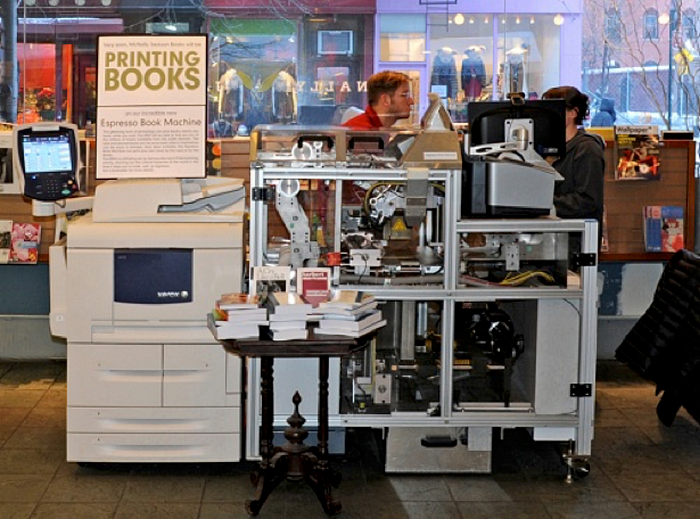
What the book printing or print on demand (POD) machine does for your store is multifold -
- You don’t have to turn away customers for lack of titles, thus delivering a better experience. At the core of the retail experience is instant gratification, walking out with what you came for. And that is just what the Espresso book machine delivers on.
- You don’t have to stock multiple copies of a title. You can print on the spot to meet demand. Also, the POD machine can help you restrict the titles that you invest in to a more manageable number (~12–15,000 or so), and ideally those that tend to sell on touch and feel
- The inventory space that is freed thanks to the POD machine can now be used for curated displays, which help sell titles, or for other revenue streams such as the coffee shop
- The machine can be used to print copies of private books, family memoirs or even small runs of books by locals, thus building bridges with the local community as well create a new revenue stream
The POD machine is really delivering a triple benefit as it reduces inventory carrying cost, enhances the shopping experience, while helping you enhance curation through the increase space available. No other idea comes close to the POD machine in the multifold impact it has on the retail business model.
Examples: Many prominent independent book stores have installed the POD machine, including NYC’s Shakespeare & Co and McNally Jackson, Boston’s Harvard Book Store and recently La Librairie des PUF, Paris.
2. Sell books beyond the store, not just within it
Focus on driving book sales beyond the confines of the store. This could be through e-commerce, book subscription services or even through pop-up stores in different locations. Ideas that help bring in revenues outside the store are critical, as it reduces the importance of location somewhat, and gives you the freedom to explore a less-prime location with lower rentals.
Heywood Hill in London is a great example of a store that does a substantial amount of business via its website, though largely for subscription packages such as its ‘A Year in Books’ where customers pay £200 for getting 12 books, one every month, curated by Heywood’s staff, delivered to their homes. Powell’s in Portland has a subscription bundle called Indiespensables focused on indie books.
A Year in Books, Heywood Hills’ book Subscription Service
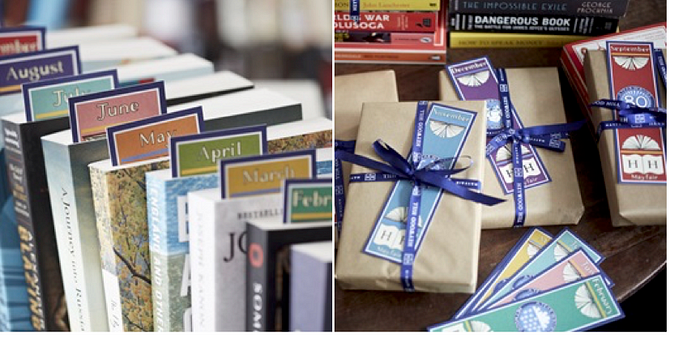
Selling book subscription brings in additional monies, stresses the curation aspect and critically moves revenues beyond the store. Heywood Hill also offers other book services such as designing libraries, or curating a collection in a specific field for a customer. Mumbai’s Trilogy bookstore has a similar offering as well.
On the subject of online sales, I haven’t come across examples of a physical store that also does a lot of sales online. The challenge, I suppose, would be two-fold — inventory carrying costs as well as setting up last-mile distribution networks. Both can be overcome. Inventory costs can be reduced via the POD machine, while you can ensure delivery to the customer by partnering with logistics companies.
Harvard Bookstore near Boston, and Square Books in Oxford, Mississippi have set up distribution systems that can offer same-day or next day delivery. Harvard Bookstore in fact uses bike messengers to deliver!
And lastly, bookstores could also explore pop-up or temporary stores allied to events, fairs, exhibitions, or even moving stores like Parnassus’ book vans. Strand Bookstore, Mumbai in its heydays had an annual book sale where they organized a week-long ‘book fair’ in a larger venue with bargain prices on many books.
Parnassus On Wheels, Parnassus Books, Nashville

3. Build a non-book revenue stream
The coffee-shop is the obvious non-book revenue stream; one that is very popular with bookstores. There are also bookstores that have consciously invested to create a sizeable food service operation within their stores. Books & Books, Miami, Feltrinelli’s RED (E stands for Eat) store in Milan and Florence, and Oxford Bookstore in India with its Cha Bar are great examples of bookstores built ground up with food being a key part of the revenue mix.
Restaurant at Books and Books, Miami
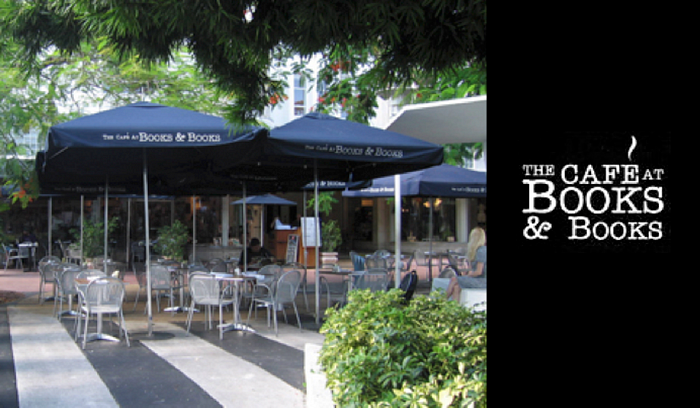
For stores looking to start with a smaller food service offering, one important advice from the folks at Politics and Prose, the renowned Washington, DC, bookstore, is toalways subcontract the coffee shop, and instead specialize on what you do best, selling books.
Beyond food, the other big opportunity is in offering courses / workshops, including in locations outside the store. Examples of these include Kolkata’s cult Seagull store which offers courses on Editing and Book Design, and Washington DC’s Politics and Prose, which offers courses on an eclectic range of topics including understanding the middle east, memoir writing, Ulysses, as well as ‘Readers’ Retreats’ / travel programs etc.
Seagull School of Publishing’s Editing Course
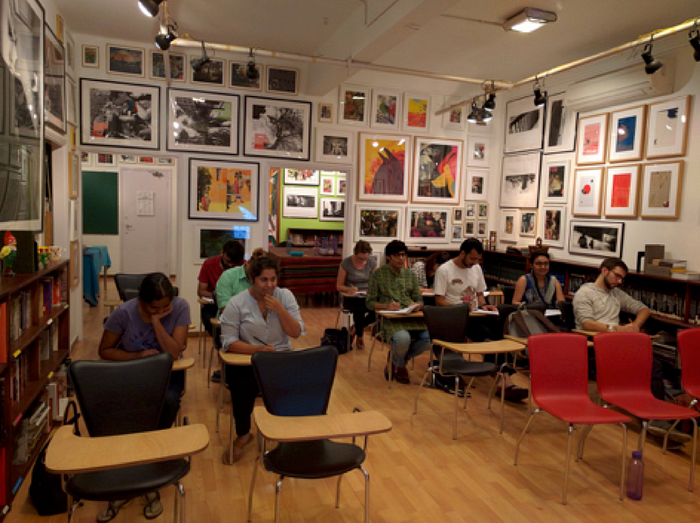
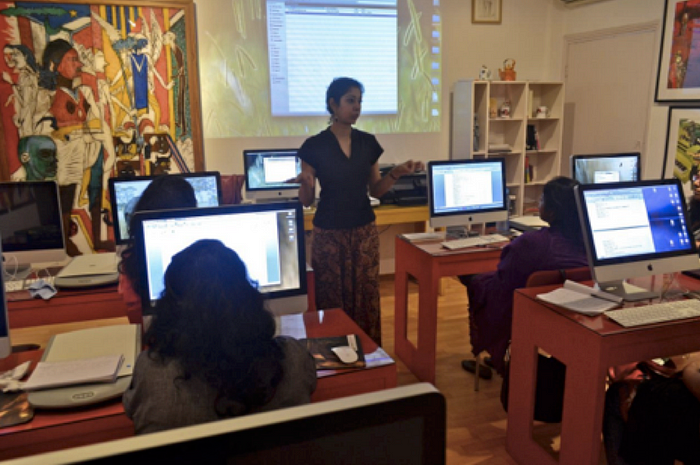
What these workshops do is bring in some welcome revenue, and build bridges between the store and users (and in some cases, between authors and readers). They also help position the store as a hub for all things literary, than just as a hub for books.
4. Memberships
If you are launching your store in the near future, then use a membership scheme to source funds and lock in community connect. Brooklyn’s Greenlight bookstore raised over $70K of their startup capital via their community lender scheme. Do not assume that a membership scheme is restricted to only stores about to launch. You can do this even if your store has been in existence a while.
The membership scheme helps in multiple ways. One, it brings in money. Two, it helps you identify your fans or core users. Three, it gets these power users committed to spending in your store. Lastly, it forces you to do something special for these members — it could be a few bucks off on every book they buy, or special events they can attend etc., but what these do is to heighten the retail experience and create a lock-in on both sides.
Beyond Greenlight, I found Politics and Prose too offering a membership service. Many stores have a customer loyalty or frequent buyer program, but I haven’t found any other prominent examples of stores which have membership programs.
5. Stress curation and discovery
Get your staff to recommend their preferred works from the new crop, or even to curate a collection of their all-time favourites. Beyond stressing discovery, a key offering of physical bookstores, it also encourages conversations between customers and staff. Prominent bookstores that get it right include Citylights, San Francisco and Elliott Bay Book Co, Seattle.
Staff Recommendations, Elliott Bay Books, Seattle
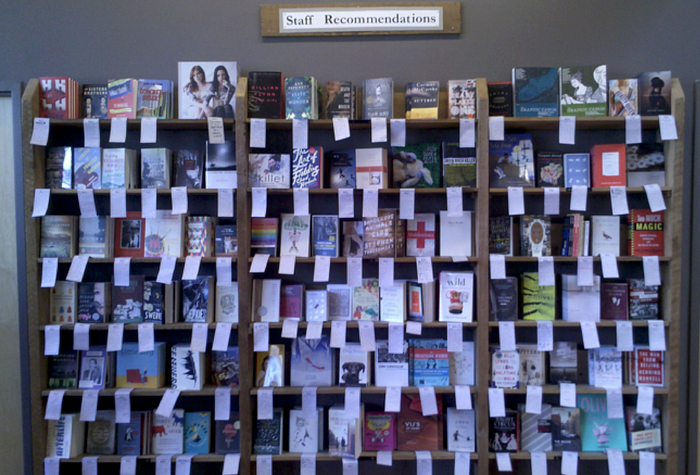
Strand Book Store of NYC has a concept they call Author’s Bookshelf, where they ask well-known writers to share what their bookshelf of say 50 books looks like. Similarly,One Grand Books in Narrowsburg in upstate New York invites writers, artists, well-known personalities to suggest their 10 fave books which are displayed prominently.
The Author’s Bookshelf, Strand NYC
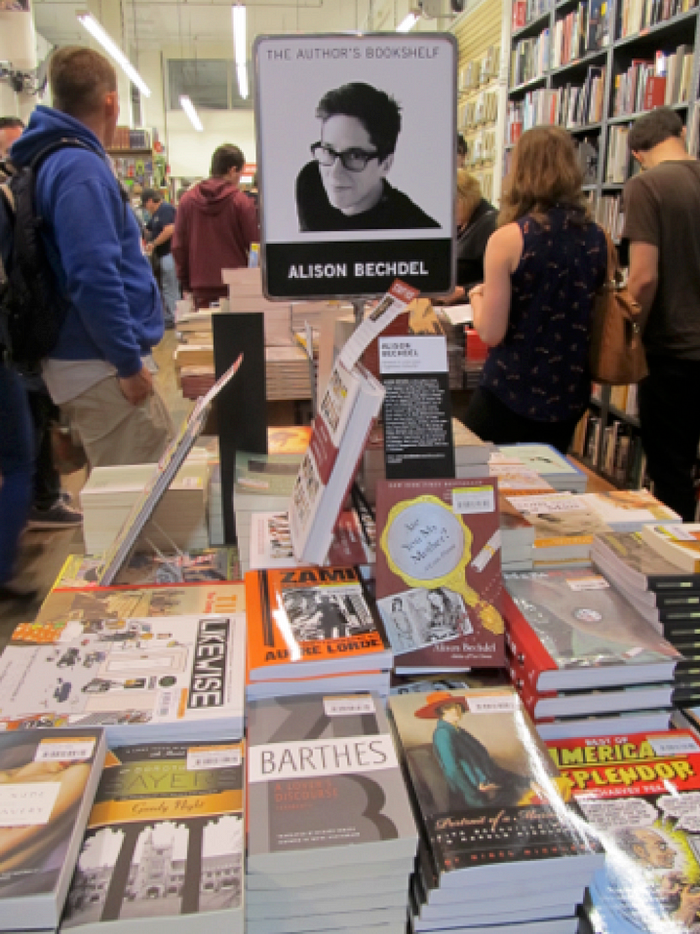
Libreria, a London-based bookstore which launched this year, has taken an innovative tack in the way it has organized its shelves, not by category but by themes. Books are catalogued by themes such as “The Sea and the Sky” and “Mothers, Madonnas and Whores”, than Geography or History or Science. The objective here is to create the possibility of serendipity, a book on physics next to one on poetry.
Another way to sell serendipity is to explore selling used titles at low prices or even rare books (first editions or collectibles) from the store. The reason is the eclectic and quirky mix of titles that typically results from an aggregation of used and rare books. They also celebrate the physical format, given that these cannot be substituted by ebooks.
Harvard Bookstore in Cambridge does this, as does Schuler Books, Michigan.
6. Schedule regular events
Holding regular book readings enhance the store experience and reinforces its status as a hub for all things literary. Harvard Bookstore hosts close to 300 events a year.Brookline Booksmith hosts about 150. Politics and Prose’s readings are even broadcast by C-SPAN on account of the audience it aggregates. Closer home, Atta Galatta in Bangalore is as much an events space (and coffee shop) as it is a bookstore, hosting workshops, book readings and even plays!
Story Pods for readings, author interaction etc (Foyle’s, Birmingham)
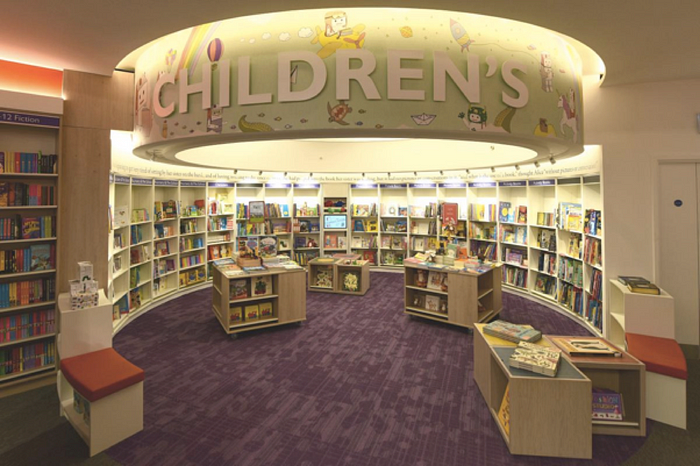
In addition, if you have the space, and are in the right location (and audience base) you can even do a lot of non-literary events such as movie screenings, quizzes etc. The Bookworm in Beijing hosts a number of events such as movie screenings, comedy nights, lectures, literary festivals, and various poetry and writing workshops. They even have whiskey tasting evenings. The Bookvine in Cherokee, Ohio similarly has wine tasting sessions.
Another Country, Berlin has board game nights. “Another Country is also a club which hosts readings, cultural events, social evenings, film nights and many other things (from their website).”
Incidentally, Beijing’s Bookworm also holds an acclaimed annual literary festival. While this may not always be possible for a smaller bookstore to pull off, one option is to think small, and perhaps explore themed festivals — a Crime & Mystery Fest or a SciFi & Comics fest.
Bookworm Literary Festival 2015
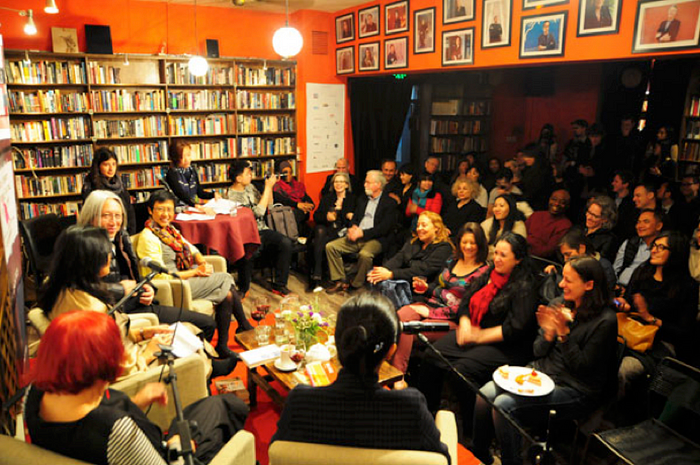
Lastly, local book clubs could be invited to use store space on low-traffic days (mon or tue evenings) for a small fee or for a minimum spend on food. Alternately you can also create your own book club exclusively for your members. Certain author events could be restricted exclusively for these member-only clubs.
7. Sell bookswag or even adjacent products
Bookswag is stuff such as bookmarks, stationery, book bags, etc. Strand NYC has the most extensive collection of any book store, i would imagine, including t-shirts, mugs etc. See it here.
A display case pairing books with wine for sale in Feltrinelli’s RED store
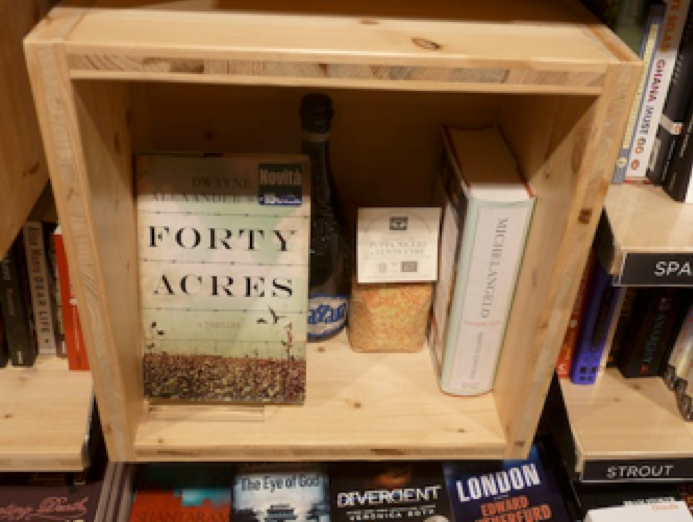
Another store that does something similar is Brookline Booksmith. “At Brookline Booksmith in Brookline, a third of the floor space gets ceded to products that complement nearby books: spatulas and wine stoppers next to cookbooks, say, or vases and floral stationery in the gardening section.”
8. Follow common sense stocking principles
Do not keep books that people wouldn’t want to browse: reference, technical guides, legal textbooks, dictionaries etc. These will typically be ordered online, or will turn over very slowly.
Keep books that cannot be published as ebooks; ideally ones that can be appreciated in the physical format, such as Judith Schalansky’s Atlas of Remote Islands.
Leverage the POD machine to keep lower numbers of a title, or even explore eliminating the title from the store. If a customer asks for it, you can always print it. The only risk is that you may miss out on display-led sales.
9. Rethink the traditional store layout.
Relook at the layout such that maximum space can be created to expand space for a reading or a workshop; or even if you want to expand the café in the evening. One way to do that is to have moveable bookshelves, and as few permanent fixtures as possible in the middle of the store.
Consider eliminating the billing counter. With wireless card readers, you don’t need a billing counter as that takes the space of a couple of shelves.
Further, thanks to the POD machine, bookstores don’t need to hold as much inventory as before. Less stock means more space again; to play around with displays which drive sales, such as curated shelves by authors, thematic displays around a particular subject such as Islam or Olympics with face front or table top displays.
10. Offer promotion and distribution service to independent authors and publishers
Thanks to online retail and the arrival of POD options, prominent bookstores are exploring publishing as a new revenue opportunity (e.g., Kolkata’s Seagull, Singapore’s Books Actually etc.) or at the least support local or independent publishers reach their audiences. Boulder Book Store in Boulder, Colorado offers publishing, promotional and distribution services to authors as per a tiered fee structure.
A hub for all things literary
The big idea for the post-amazon store is to move away from being a hub for books to being a hub for all-things literary, or even a hub for ideas. A place you go to get new perspectives and soak in new contrasting viewpoints. A bookstore thus becomes less about books per se than enabling a lifestyle around books.
With a view to be a literary hub, stores are being designed to host readings & workshops, accommodate a café and even thematic displays. The spaces are all flexible — movable or revolving shelves so that space can be cleared for events.
The revenue model now expands beyond selling books within the store to selling the literary experience — discovery / curation, experience including events, food and merchandise. Stores which are able to move nimbly to tap monies across multiple sources will set themselves up with the best chances of survival.
The holy grail for a new bookstore should be get revenues from selling non-book services (restaurants, merchandise, workshops etc) and selling book services (subscriptions, curating services) and e-commerce, closer to that of book sales within the store.
Disclosure
In advance of the London megastore Foyles’ relocation in 2014, which meant new architectural layouts for their 40,000 sq ft store, they encouraged an open brainstorming on the subject, in partnership with UK trade rag The Bookseller, to generate ideas that they could implement in their store. The resulting comprehensive report of the brainstorm, titled Future Foyles, is worth a read.
You will see some common ideas between the recommendations made in the report and my article. That is only natural, as good ideas spread naturally and bookstores look to adapt what is working in one geography to another. Still what you won’t find in the report are the examples of where these best practices abound, which I have detailed in my article.
A longer, and albeit more detailed version of this article is available on my website.
